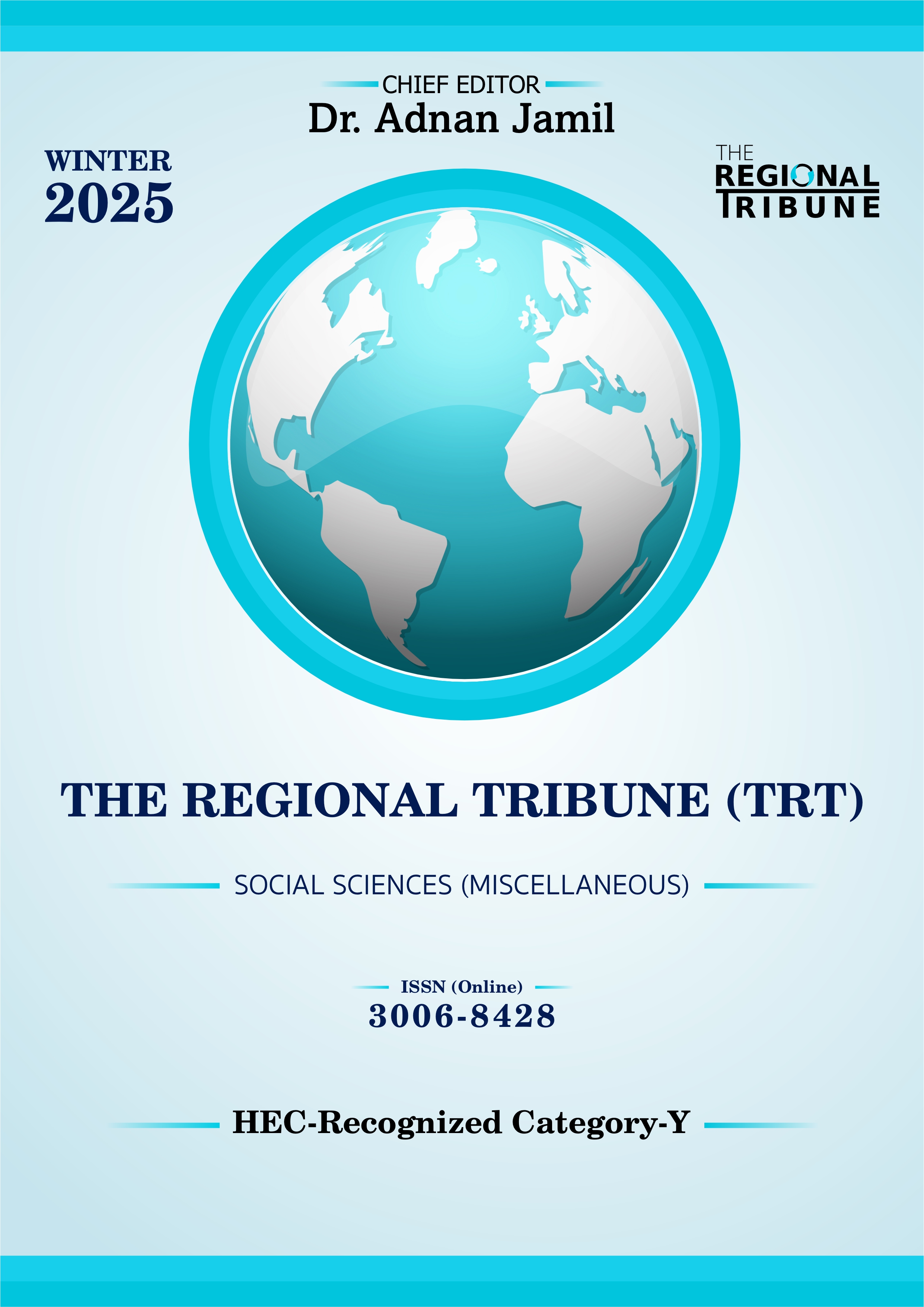Development of Social Skills among Children with Autism Spectrum Disorder through Video Modeling
DOI:
https://doi.org/10.55737/trt/WR25.108Keywords:
Social Skills, Video Modeling, Autism Spectrum Disorder, Greetings, SharingAbstract
Children with Autism Spectrum Disorder (ASD) often experience significant challenges in developing social skills, which can impact their ability to engage with peers and function in various social contexts. This study explores the development of social skills among children with Autism Spectrum Disorder (ASD) through video modeling intervention. Two ASD students, aged 5-10 years, were selected using purposive sampling from a local therapy center. The aim was to assess whether video modeling could improve their social behaviors, such as greetings, sharing, and peer interactions. Prior to the intervention, a pre-assessment was conducted, where teachers identified challenges in teaching social skills to the children. A 40-50 second video, demonstrating appropriate social behaviors, was developed and presented to the children in a controlled environment. The children watched the video multiple times over several sessions, with opportunities to practice the learned behaviors. Data was collected through a behavioral monitoring sheet, where teachers tracked whether the children successfully imitated the modeled behaviors after each session. Follow-up sessions ensured retention of skills by encouraging real-world practice. Post-assessment was carried out to compare teachers' perceptions of the children's progress in social skills before and after the intervention. The findings suggest that video modeling is effectively enhancing social skills in children with ASD, particularly in greeting peers, sharing, and engaging in simple conversations. The results highlight the potential of video modeling as an effective tool for teaching social skills to children with ASD.
References
Alatawi, M. (2024). Empowering minds: Exploring the Impact of AI in Facilitating Inclusive Education for Students with Intellectual Disabilities. Journal of Arts, Literature, Humanities and Social Sciences, (106), 358-380. https://doi.org/10.33193/JALHSS.106.2024.1131
Alhuzimi, T. (2022). Efficacy of video modelling (VM) in developing social skills in children with autism spectrum disorder (ASD) at school in Saudi Arabia. International Journal of Disability, Development, and Education, 69(2), 550–564. https://doi.org/10.1080/1034912x.2020.1716962
Altaf, E. (2020). The Effects of Continuous Video Prompting on Teaching Daily Living Skills to Individuals with Autism Spectrum Disorder. FIU Electronic Theses and Dissertations. 4503. https://digitalcommons.fiu.edu/etd/4503
Alzyoudi, M., Sartawi, A., & Almuhiri, O. (2015). The impact of video modelling on improving social skills in children with autism: Video Modelling. British Journal of Special Education, 42(1), 53–68. https://doi.org/10.1111/1467-8578.12057
American Psychiatric Association. (2013). Diagnostic and statistical manual of mental disorders (5th ed.). Arlington, VA: American Psychiatric Publishing.
Bellini, S., & Akullian, J. (2007). A meta-analysis of video modeling and video self-modeling interventions for children with autism spectrum disorders. Exceptional Children, 73(3), 264-287. https://doi.org/10.1177/001440290707300301
Charlop-Christy, M. H., Le, L., & Freeman, K. A. (2000). A comparison of video modeling with in vivo modeling for teaching children with autism. Journal of Autism and Developmental Disorders, 30(6), 537-552. https://doi.org/10.1023/A:1005532827733
Charlop, M. H., Dennis, B., Carpenter, M. H., & Greenberg, A. L. (2010). Teaching socially expressive behaviors to children with autism through video modeling. Education and treatment of children, 33(3), 371-393. https://doi.org/10.1353/etc.0.0104
Dodd, J. L., Franke, L. K., Grzesik, J. K., & Stoskopf, J. (2014). Comprehensive multi-disciplinary assessment protocol for autism spectrum disorder. Journal of Intellectual Disability - Diagnosis and Treatment, 2(1), 68–82. https://doi.org/10.6000/2292-2598.2014.02.01.9
Edinyang, S. D. (2016). The significance of social learning theories in the teaching of social studies education. International Journal of Sociology and Anthropology Research, 2(1), 40-45.
Fragale, C. L. (2014). Video modeling interventions to improve play skills of children with autism spectrum disorders: A systematic literature review. Review Journal of Autism and Developmental Disorders, 1(3), 165–178. https://doi.org/10.1007/s40489-014-0019-4
Gül, S. O. (2016). The combined use of video modeling and social stories in teaching social skills for individuals with intellectual disability. Educational Sciences: Theory and Practice, 16(1), 83-107. https://doi.org/10.12738/estp.2016.1.0046
Kamps, D. M., Mason, R., & Heitzman-Powell, L. (2017). Peer mediation interventions to improve social and communication skills for children and youth with autism spectrum disorders. In Handbook of Social Skills and Autism Spectrum Disorder (pp. 257–283). Springer International Publishing. http://dx.doi.org/10.1007/978-3-319-62995-7_16
Kanner, L. (1943). Autistic disturbances of affective contact. Nervous child, 2(3), 217-250.
Khalid, M. U., Fazil, H., & Qureshi, M. S. (2023). Development of Social Skills by Using Simulation Method for Children with Autism Spectrum Disorder. Journal of Development and Social Sciences, 4(3), 459-478. http://dx.doi.org/10.47205/jdss.2023(4-III)45
Kucskar, M. (2017). A Comparison of the Effects of Video Modeling Other and Peer-Implemented Pivotal Response Training to Video Modeling Other on Positive Social Interactions of Young Children with Developmental Disabilities (Doctoral dissertation, University of Nevada, Las Vegas).
Lal, R., & Shahane, A. (2011). TEACCH Intervention for Autism. In Autism Spectrum Disorders - From Genes to Environment. InTech. http://dx.doi.org/10.5772/17564
McCoy, K., & Hermansen, E. (2007). Video modeling for individuals with autism: A review of model types and effects. Education and treatment of children, 30(4), 183-213. https://doi.org/10.1353/etc.2007.0029
McCoy, R. A., & Hermansen, M. (2007). The effects of video modeling on social behaviors in children with autism. Journal of Positive Behavior Interventions, 9(2), 105-113. https://doi.org/10.1177/10983007070090020101
Mechling, L. C. (2011). Review of twenty-first century portable electronic devices for persons with moderate intellectual disabilities and autism spectrum disorders. Education and Training in Autism and Developmental Disabilities, 479-498. https://www.jstor.org/stable/24232361
Nikopoulos, C. K., & Keenan, M. (2004). Using video modeling to teach complex social skills to children with autism. Behavior Modification, 28(3), 431-448. https://doi.org/10.1177/0145445503259320
Parveen, Z., Rashid, A., & Khalid, M. U. (2023). MANAGING BEHAVIORAL ISSUES OF STUDENTS WITH HEARING IMPAIRMENT THROUGH VIDEO MODELING: ACTION RESEARCH STUDY. Pakistan Journal of Educational Research, 6(2). https://doi.org/10.52337/pjer.v6i2.879
Rashid, A., & Khalid, M. U. (2024). Relationship between Cognitive skills and Social Skills among Children with Autism Spectrum Disorder. Al-Mahdi Research Journal (MRJ), 5(5), 74-87. https://ojs.mrj.com.pk/index.php/MRJ/article/view/433
Reagon, K. A., Higbee, T. S., & Endicott, K. (2006). Teaching pretend play skills to a student with autism using video modeling with a sibling as model and play partner. Education and treatment Of children, 517-528. https://www.jstor.org/stable/42899899
Reagon, K. A., Higbee, T. S., & Endicott, K. (2006). Using video modeling to teach peer interactions to children with autism. Journal of Applied Behavior Analysis, 39(3), 369-373. https://doi.org/10.1901/jaba.2006.55-05
Rhinehart, B. A. (2011). Video modeling for teaching social skills to students with autism spectrum disorders (Doctoral dissertation, University of Dayton).
Sansosti, F. J., & Powell-Smith, K. A. (2008). Using computer-presented social stories and video models to increase the social communication skills of children with highfunctioning autism spectrum disorders. Journal of Positive Behavior Interventions, 10(3), 162-178. https://psycnet.apa.org/doi/10.1177/1098300708316259
Seema, P., & Ajithkumar, V. V. (2019, February). Effectiveness of Vipassana meditation on communication skills of employees. In SIMSARC 2018: Proceedings of the 9th Annual International Conference on 4C’s-Communication, Commerce, Connectivity, Culture, SIMSARC 2018, 17-19 December 2018, Pune, MH, India (p. 158). European Alliance for Innovation.
Shipley-Benamou, R., Lutzker, J. R., & Taubman, M. (2002). Teaching daily living skills to children with autism through instructional video modeling. Journal of Positive Behavior Interventions, 4(3), 166–177. https://doi.org/10.1177/10983007020040030501
Shipley-Benamou, R., Lutzker, J. R., & Taubman, M. (2002). Teaching children with autism to initiate mands using video modeling. Journal of Applied Behavior Analysis, 35(2), 213-228. https://doi.org/10.1901/jaba.2002.35-213
Shukla-Mehta, S., Miller, T., & Callahan, K. J. (2010). Evaluating the effectiveness of video instruction on social and communication skills training for children with Autism Spectrum Disorders: A review of the literature. Focus on Autism and Other Developmental Disabilities, 25(1), 23–36. https://doi.org/10.1177/1088357609352901
Tantam, D. (2000). Psychological disorder in adolescents and adults with Asperger syndrome. Autism: The International Journal of Research and Practice, 4(1), 47–62. https://doi.org/10.1177/1362361300004001004
Whalon, K. J., Conroy, M. A., Martinez, J. R., & Werch, B. L. (2015). School-based peer-related social competence interventions for children with autism spectrum disorder: A meta-analysis and descriptive review of single case research design studies. Journal of autism and developmental disorders, 45(6), 1513-1531. https://doi.org/10.1007/s10803-015-2373-1
White, S. W., Keonig, K., & Scahill, L. (2007). Social skills development in children with autism spectrum disorders: A review of the literature. Research in Autism Spectrum Disorders, 1(1), 57-74. https://doi.org/10.1016/j.rasd.2006.09.001
Yakubova, G., & Taber-Doughty, T. (2013). Effects of video modeling and verbal prompting on social skills embedded within a purchasing activity for students with autism. Journal of Special Education Technology, 28(1), 35-47. http://dx.doi.org/10.1177/016264341302800104
Downloads
Published
Issue
Section
License

This work is licensed under a Creative Commons Attribution-NonCommercial 4.0 International License.



